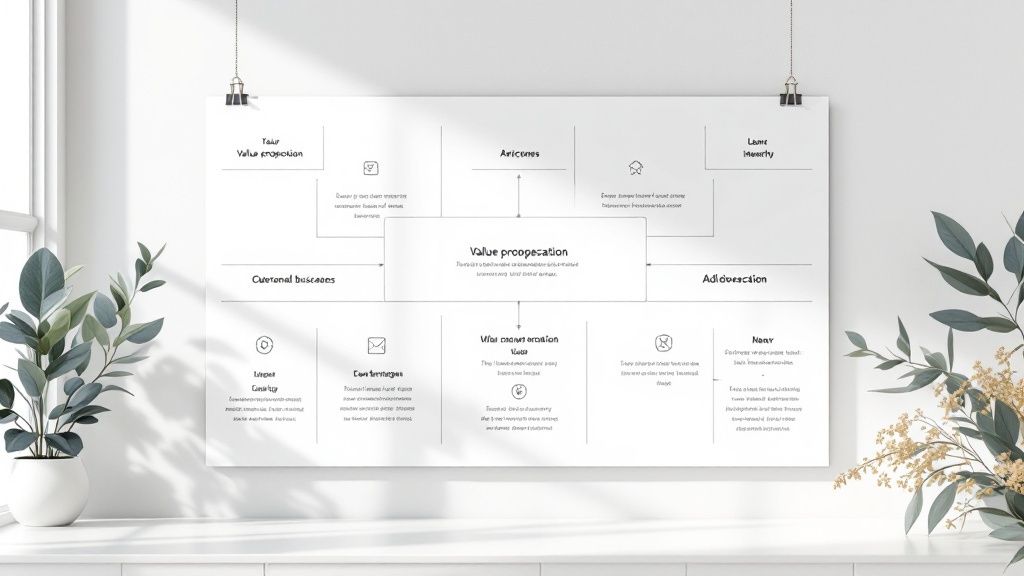Effective B2B Value Proposition Canvas for Growth
April 4, 2025

Crafting Effective Value Proposition Canvases for B2B SaaS and Tech Startups
The Value Proposition Canvas is an essential framework for aligning your B2B SaaS product with the needs of your business clients. It serves as a connector between your offerings and what your business clients seek. This connection depends on two primary elements: the Customer Profile and the Value Map. Understanding their interaction is crucial for developing an engaging value proposition.

Delving Into the Customer Profile
The Customer Profile captures the business client's viewpoint, focusing on three key components:
- Customer Jobs: These are the tasks your business clients aim to complete, such as automating workflows or improving team collaboration.
- Customer Pains: These refer to the challenges and obstacles business clients face while trying to achieve their jobs. For instance, a company might find it difficult to integrate various software tools seamlessly.
- Customer Gains: These are the benefits and positive outcomes your business clients desire, like enhanced productivity or improved data security.
A thorough understanding of your target business clients forms the bedrock for creating a product they truly appreciate. Historically, concentrating on these elements has helped tech startups understand client needs and develop solutions that address those needs. This framework, introduced by Dr. Alexander Osterwalder, is now essential for successful product design. By pinpointing the most important pains and gains, tech companies can adjust their offerings to boost client satisfaction. This strategic approach also mitigates the risk of failure. Approximately 20% of startups fail within the first two years due to not meeting market needs. Learn more about the Value Proposition Canvas here.
Constructing the Value Map
Once you have a robust Customer Profile, you can develop the Value Map. This illustrates how your product addresses your client's needs:
- Products & Services: This includes all that your business offers, such as software features, technical support, and consulting services.
- Pain Relievers: This outlines how your products and services ease client pain points. For example, a comprehensive analytics dashboard could resolve the issue of fragmented data insights.
- Gain Creators: This describes how your offerings help clients achieve their desired benefits, such as driving efficiency or facilitating better decision-making.
Achieving Product-Market Fit
The Value Proposition Canvas's effectiveness arises from the synergy between the Customer Profile and the Value Map. A well-constructed canvas clearly links client needs with the value your product provides. Tech companies can ensure they create solutions that genuinely solve client problems and deliver desired outcomes by precisely mapping these elements. This leads to greater client satisfaction and business success. To further enhance business growth, consider implementing B2B marketing automation tools. This structured approach uses data-driven insights to help businesses make informed decisions and outperform competitors.
Creating Your First Value Proposition Canvas: A Practical Guide

Let's transition from theory to practice. This section offers a practical example of creating your own value proposition canvas, using a fictional SaaS company, "TechFlow," that provides workflow automation for medium-sized enterprises. This guide shows how to convert client insights into a focused value proposition.
Defining the Customer Profile for TechFlow
The first step in building a value proposition canvas is understanding your client. For TechFlow, our target client is a medium-sized enterprise overwhelmed by manual processes.
What are their specific needs? What challenges do they face? And what do they hope to gain? These are the critical questions the Value Proposition Canvas helps answer.
- Customer Jobs: These enterprises need to streamline their operations, integrate various software tools, and ensure security compliance. They are managing numerous tasks and require a cohesive solution.
- Customer Pains: They struggle with data silos that hinder decision-making. They also have concerns about security breaches and the inefficiency of manual workflows. These issues lead to operational inefficiencies and increased costs.
- Customer Gains: They want to enhance operational efficiency and ensure robust data security. They also aim to improve team collaboration and decision-making. Achieving these gains directly impacts their profitability.
This detailed client profile forms the basis of our value proposition. It’s the foundation for building our Value Map.
Crafting the Value Map for TechFlow
Now, let's explore how TechFlow addresses these needs with a compelling Value Map. This map outlines the specific ways our product creates value for our target client.
- Products & Services: TechFlow offers an intuitive platform that automates workflow processes, integrates with existing software, and provides comprehensive security features. It also includes industry-specific templates to save time and resources.
- Pain Relievers: The platform alleviates the pain of data silos by offering an integrated system. It addresses security concerns with advanced encryption and compliance tools. Additionally, it improves workflow efficiency through automation.
- Gain Creators: TechFlow creates gains by providing tools for enhanced collaboration and real-time data insights. Its analytics capabilities help users track performance and optimize operations for better outcomes.
Visualizing the Value Proposition Canvas
A completed value proposition canvas provides a clear, visual representation of how your product aligns with client needs. To better illustrate the components and their relationships, let’s look at a table summarizing our TechFlow example.
The following table, "Value Proposition Canvas Core Components," breaks down each element in our completed example.

As this table shows, a well-defined Value Proposition Canvas ensures a strong product-market fit. Each element works together to create a compelling offering that resonates with the target client.
This value proposition canvas example demonstrates how TechFlow directly addresses the needs and desires of its target client. By meticulously mapping out both the client profile and the value map, tech companies can create a product that truly resonates with their audience and drives business growth. This structured approach enables informed decision-making and creates a roadmap for future development and marketing efforts.
Success Stories With the Value Proposition Canvas

Real-world examples provide valuable insights into the effectiveness of the Value Proposition Canvas. Examining companies that have successfully used this framework offers a practical understanding of transforming a product from struggling to thriving. These success stories illuminate the path to achieving product-market fit.
How Tech Startups Use the Value Proposition Canvas to Identify Market Gaps
Tech startups often face the challenge of entering competitive markets. The Value Proposition Canvas provides a structured approach to identifying unmet client needs and differentiating their offerings.
Consider a startup developing a project management tool. By focusing on client pains like inefficient communication and lack of transparency, they can design features that directly address these issues. This creates a compelling value proposition.
This strategic approach helps startups stand out from established competitors and allows them to build a loyal client base from the start. By identifying and addressing specific needs, startups can establish themselves as the preferred solution for a particular client segment.
Revitalizing Declining Product Lines With the Value Proposition Canvas
Established tech companies also benefit from the Value Proposition Canvas, especially when revitalizing declining product lines. Consider a software company with a legacy product facing declining market share.
By revisiting the Customer Profile and identifying evolving client needs, they can pinpoint new pain points and desired gains that the product doesn't currently address. This renewed understanding of the client can spark innovation and lead to product improvements that re-engage existing clients and attract new ones.
For instance, adding features that improve collaboration or simplify workflows could breathe new life into a stagnant product. Globally, the Value Proposition Canvas has been used across various industries to refine product-market fit.
For example, in the technology sector, companies like Airbnb have leveraged this framework to identify client pains and gains in the accommodation rental market. By offering solutions such as accessibility and affordability, Airbnb has carved out a unique niche for itself. The canvas's effectiveness in identifying pains (e.g., high costs, lack of personal touches) and gains (e.g., convenience, community feel) helps businesses like Airbnb tailor their offerings to meet these needs effectively. Explore this topic further here.
Boosting Client Retention for B2B Service Providers
B2B service providers can leverage the Value Proposition Canvas to increase client retention by focusing on alignment. By carefully mapping their services to client gains, they can demonstrate clear value and build stronger relationships.
For example, a marketing agency can use the canvas to uncover hidden client gains, like increased brand awareness or improved lead generation. They can then tailor their services to directly contribute to these desired outcomes.
From Canvas Insights to Measurable Results: Real-World Strategies
These examples highlight the versatility of the Value Proposition Canvas. Whether you're a startup disrupting an industry, an established company looking to revitalize existing products, or a service business seeking to increase client retention, this framework can be useful in achieving meaningful results.
Implementing the canvas isn't just about creating a document; it's about embedding client-centric thinking into your business strategy and using it to drive growth and change. By systematically understanding and addressing client needs, businesses can build products and services that truly resonate with their target audience and achieve long-term success.
Avoiding Common Mistakes in Your Value Proposition Canvas

Creating a Value Proposition Canvas is more than simply filling in the blanks. It's about truly understanding your client. Even experienced teams can make mistakes that render their canvas ineffective. This section explores these potential pitfalls and offers solutions for creating a value proposition canvas that delivers results.
The Danger of Confirmation Bias
One of the most common mistakes is confirmation bias. This occurs when you seek information that supports your existing beliefs about your client and their needs. You might assume, for example, that your product solves a specific pain point without sufficient evidence. This can lead to developing features no one wants, wasting valuable resources. To avoid this, actively look for information that challenges your assumptions. Be open to revising your understanding of your client.
Superficial Research: A Path to Failure
Another pitfall is conducting superficial research. Asking a few clients about their needs isn't enough. You need to understand the why behind their answers to identify underlying needs. This means using various research methods like interviews, surveys, and user testing. Analyzing competitor offerings can also highlight unmet needs and opportunities for differentiation. This deep understanding will enrich your value proposition canvas with actionable insights.
The Problem With Overly Broad Client Segments
Defining your client segment too broadly weakens your value proposition. Trying to appeal to everyone often appeals to no one. This happens when companies try to capture the largest possible market share. By focusing on a specific niche, you can tailor your message and product development to meet unique needs. This focused approach results in a stronger value proposition and happier clients. Consider developing multiple canvases for different client segments to deliver a relevant message.
Prioritizing Pains and Gains: A Key to Success
Not all pains and gains are equal. Prioritize those that truly matter to your client. A minor inconvenience, for example, might be less important than significant cost savings. Use a prioritization matrix to rank client needs based on their importance and frequency. This helps you focus on addressing the most critical issues and maximizing the impact of your product or service. Prioritization enhances your value proposition canvas and shows a real understanding of client value.
Validating Your Assumptions: Avoiding Costly Mistakes
Finally, remember to validate your assumptions. Creating a Value Proposition Canvas is just the first step. Test your hypotheses with real clients to ensure your value proposition resonates and addresses their actual needs. This might involve A/B testing different messaging, prototyping product features, or running pilot programs. This validation minimizes the risk of expensive product development mistakes and ensures your product delivers real value. This final validation step refines your value proposition canvas, turning it into a blueprint for growth.
Industry-Specific Value Proposition Canvas Templates
Building a Value Proposition Canvas from scratch can feel overwhelming. Why not learn from existing markets? This section provides value proposition canvas examples across several key industries: B2B SaaS, healthcare technology, financial technology, and enterprise software. These templates offer a practical starting point for developing your own compelling value proposition.
To further illustrate the nuances of Value Proposition Canvases across different sectors, let's examine some specific examples in a comparative table:
Value Proposition Canvas by Industry
Comparison of key client jobs, pains and gains across different industries

This table highlights how client priorities shift across different industries. While a B2B SaaS client values integration and security, a healthcare technology client prioritizes patient outcomes and cost savings. Understanding these differences is key to crafting a resonant value proposition.
B2B SaaS: Enhancing Operational Efficiency
B2B SaaS solutions thrive on improving efficiency and security for business clients.
- Customer Jobs: Streamlining operations, automating repetitive tasks, and ensuring data security.
- Customer Pains: Integration challenges, security concerns, and complex user interfaces.
- Customer Gains: Enhanced operational efficiency, seamless integration with existing systems, and improved data security.
Effective B2B SaaS value propositions address these core needs. Offering integration support or advanced security features directly tackles client pain points and offers tangible gains.
Healthcare Technology: Improving Patient Care
Healthcare technology providers must balance clinical effectiveness with operational efficiency.
- Customer Jobs: Managing patient data, improving care delivery, and reducing costs.
- Customer Pains: Data privacy concerns, outdated systems, and regulatory compliance challenges.
- Customer Gains: Better patient outcomes, streamlined workflows, and cost savings.
Successful healthcare technology value propositions emphasize both patient well-being and operational efficiency. Offering user-friendly interfaces or compliance support can significantly improve client satisfaction.
Financial Technology: Building Trust and Accessibility
Financial technology providers must build trust and offer secure, accessible services.
- Customer Jobs: Simplifying financial transactions, ensuring regulatory compliance, and offering personalized services.
- Customer Pains: Security risks, complex regulations, and lack of client trust.
- Customer Gains: Enhanced security, compliance with regulations, and personalized client experiences.
Successful value propositions in financial technology emphasize transparency, security, and personalization. This could include offering intuitive interfaces and robust security measures.
Enterprise Software: Driving Business Transformation
Enterprise software companies must understand business processes and create solutions that drive transformation.
- Customer Jobs: Optimizing business processes, enabling effective collaboration, and ensuring data accuracy.
- Customer Pains: High costs, difficult implementation processes, and lack of support.
- Customer Gains: Cost efficiency, smooth implementation, and reliable client support.
Strong enterprise software value propositions focus on cost-effectiveness, ease of implementation, and dependable support. Highlighting flexible pricing models or comprehensive support services can resonate with clients.
By examining these value proposition canvas examples, you can gain valuable insights into how successful businesses tailor their offerings to meet diverse client needs. These templates provide a foundation for crafting your own value proposition, enabling you to clearly communicate your unique value and resonate with your target market. A strong value proposition is essential for effective marketing and sustainable business growth.
Implementing Canvas Insights for Business Success
A well-crafted Value Proposition Canvas is only valuable when implemented effectively. This section bridges the gap between insightful planning and practical steps, offering strategies for turning your canvas into tangible business results. This is where a value proposition canvas truly comes to life, demonstrating the practical application of your planning efforts.
Prioritizing Product Features
Turning insights into action starts with prioritizing product features. Your canvas highlights client pains and gains. Use this information to shape your product roadmap.
For example, if your canvas reveals that clients struggle with complex interfaces, prioritize features that simplify user experience. This client-centric approach ensures your development efforts deliver maximum value and address the most pressing client needs.
Crafting Effective Messaging
Your Value Proposition Canvas informs your marketing messaging. By understanding your client's jobs, you can tailor your communication to resonate with their specific needs.
For instance, if your target client is a medium-sized enterprise, focus your messaging on how your product enhances operational efficiency. A value proposition canvas helps you speak directly to your ideal client, addressing their specific pain points and highlighting relevant benefits.
Aligning Your Teams
A shared understanding of client value is crucial. The Value Proposition Canvas serves as an alignment tool for cross-functional teams. It provides a common language for discussing client needs, ensuring everyone is working towards a common goal.
This unified approach promotes collaboration and focuses everyone on delivering client value. It helps break down silos and ensures consistent messaging across all departments.
Testing and Iterating
Implementing your value proposition is an iterative process. The canvas provides a framework for developing testable hypotheses about your value proposition.
This might involve A/B testing different messaging or conducting user testing on new features. Data-driven refinement allows you to continually improve your offering based on market feedback, maximizing your chances of success. Big Moves Marketing can help you test and refine your value proposition canvas, turning insights into market growth.
Tracking the Impact
Measuring impact is essential. Track key metrics aligned with the client gains identified in your canvas. This could include metrics like client satisfaction, conversion rates, or client lifetime value.
This feedback loop allows you to assess the effectiveness of your value proposition and make data-driven adjustments, ultimately leading to sustainable business growth. By continuously monitoring and adjusting, you can ensure your value proposition remains relevant and effective.
%20-%20Alternate.svg)


%20-%20white.svg)